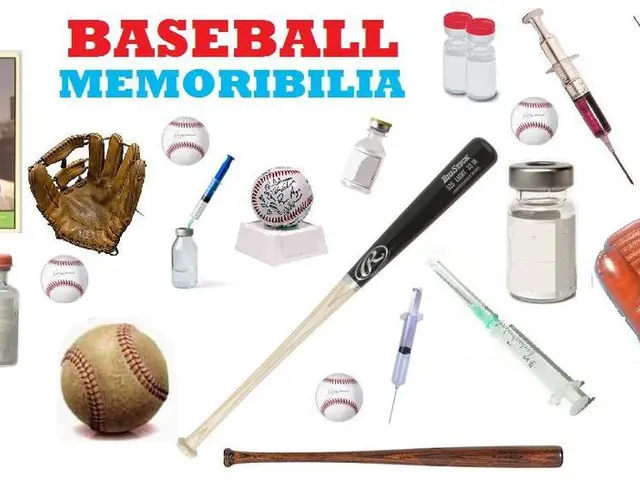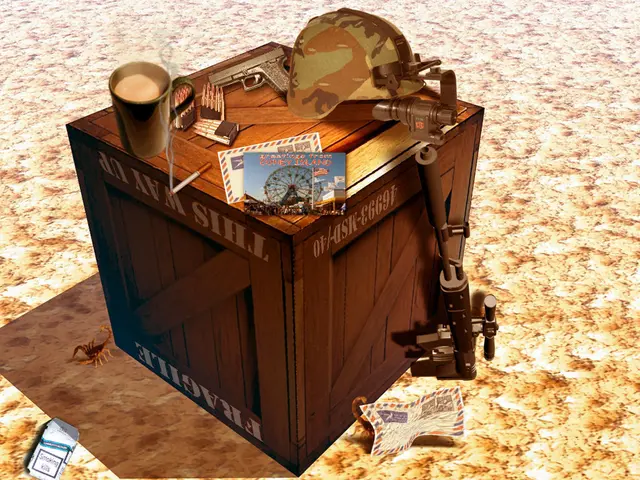What's the Lowdown on Mamma Troubles?
Mastalgia Explained: An Understanding of Breast Pain Causation and Symptoms.
Ah, breast pain - or as the cool kids call it, mastalgia. It ain't a walk in the park, especially for ladies, but understanding this common condition is crucial for anyone experiencing it. This discomfort can range from a mild nuisance to a downright pain in the proverbial neck, and it can happen in one or both puppies. Knowing what causes it and when to seek help could be the difference between a laugh and a breakdown.
Mastalgia can be cyclical, meaning it's related to your rhythm maker, or it can run its course independently - a term we like to call independently scandalous. While it's often not a death sentence, it can cause anxiety, especially when you wonder if it's a sign of something gnarlier, like tits on toast, er, breast cancer.
Now, let's make one thing crystal clear: while mastalgia is common, it isn't a disease in itself. It's usually a symptom of underlying issues, and knowing what's causing your dear old melons to freak out is imperative. If you're feeling a twinge, a poke, or a full-blown attack of sensitivity in the breast department, consulting with a healthcare pro is your best bet for figuring out what the heck is going on.
Different Types of Boob Pain
Getting to grips with the various types of mastalgia can help you identify the culprit. Here are the two main categories:
Cyclical Boob Pain
Cyclical boob pain is like your period's sidekick - it often follows the hormonal rollercoaster associated with monthly dabbles. This type of pain typically flares up in the days leading up to Aunt Flo's visit and subsides once she shows her ugly mug. Symptoms? Well, imagine a dull ache, throbbing, or heaviness in both the honkers (or just one, depending on the situation). Frequent flyers of this type of pain are often young ladies during their party years, but don't fret - it usually dies down during menopause.
Non-Cyclical Boob Pain
Non-cyclical boob pain is a rogue pain that can happen at any time and can target one or both baps. Culprits? Injury or trauma to the boob area, infections, cysts, medications, or even a lousy bra fit can all contribute. This type of pain can be localized to one breast, which might send panic bells chiming about serious conditions - but don't worry just yet, let's consult Queen Doctor first.
When to Pack Your Bags and Head to the ER?
While most cases of mastalgia are benign, there are situations when a trip to the clinic is warranted:
- Persistent Pain: If the pain sticks around like a stubborn booger, or if it's intense, you should probably book a ride with Doc ASAP.
- Nipple Changes: If you notice any lumps, changes in nipple shape, or discharge, it's time to make that appointment.
- One-Breast Pain: If you experience localized pain in one breast and it doesn't improve, it's essential to get checked out.
Remember, early detection is always best, so don't hesitate to connect with your healthcare provider if you've got concerns about your mammary joy ride.
Symptoms of Boob Sorrow (Mastalgia)
Mastalgia symptoms can be a real manager, so knowing what to expect can help you get a grip on the root cause. Here are some common signs:
Types of Boob Pain
Mastalgia can be classified into two main categories: cyclical and non-cyclical boob pain.
- Cyclical Boob Pain: This type of pain is like your period's shadow - it follows your hormones and can feel like a dull ache or discomfort in the tatas. For many ladies, this happens in the days leading up to their period.
- Non-Cyclical Boob Pain: Unlike its cyclical counterpart, non-cyclical boob pain can show up at any time and in different locations - like a surprise guest at a party.
Associated Symptoms
In addition to the primary pain, other symptoms might include:
- Sensitivity: Increased sensitivity in the breast tissue, making it a no-no to touch or to wear uncomfortable apparel.
- Swelling: Some folks may notice swelling or changes in breast size during painful episodes - gotta love that bloating!
- Nipple Discharge: In some cases, discharge may appear from the nipple, ranging in color from clear to yellow to bloody - ew, yuck, but there it is.
- Changes in Skin Texture: The skin over the breast might look dimpled, swollen, or changed in texture - boob E.T.
If you're dealing with persistent or severe boob pain, a chat with your healthcare provider is a must for a thorough examination.
Causes of Boob Pain (Mastalgia)
Wrapping your brain around the causes of mastalgia can help you develop a fight plan. Mastalgia can arise from various factors, ranging from hormonal fluctuations to lifestyle choices. Here are some common culprits:
Hormonal Whirlwind
One of the main players in mastalgia is hormonal chaos, especially the kind that's connected to the monthly dance (you guessed it - periods). These fluctuations can cause swelling and tenderness in the breast tissue. This is particularly common among young ladies during their party years. 🕺️
Lumpy Buds
Many folks deal with lumpy buds, which are non-cancerous lumps or cysts in the breast tissue. These lumps can cause discomfort and pain, and they often worsen just before Aunt Flo blows town.
Infections and Inflammation
Infections, such as mastitis, can cause localized pain and swelling in the breast. Mastitis is often associated with breastfeeding, but it can happen to those not nursing as well. Inflammation of the breast tissue can develop from injury or trauma.
Bra Worries
Ladies with larger breasts might experience more frequent boob pain due to the weight and strain on the breast tissue. Wearing a supportive bra can help alleviate some of the discomfort, so make sure you choose the perfect size and style for your bosom.
Time for a Health Check
Understanding the risk factors associated with mastalgia can help you identify potential triggers and seek appropriate treatment. While boob pain can affect anyone, certain factors can increase its likelihood:
Hormonal Swings
One of the biggest contributors to mastalgia is hormonal fluctuations. This pain is often linked to monthly rhythm alterations. Ladies will experience boob pain around the time they anticipate their period, aka cyclical boob pain. If your pain periodically aligns with your monthly visitor, hormonal fluctuations might be the issue. 🌸
Age
Age might play a role in the development of mastalgia. Young females, particularly those during their party years, are more likely to experience boob pain due to hormonal fluctuations. As ladies get older and approach menopause, the frequency and intensity of breast pain might diminish. However, keep an eye out for any new or strange pain, no matter your age.
Jumbo Jubblies
Size and density can also impact your chances of experiencing mastalgia. Ladies with larger breasts or denser breast tissue might have more instances of boob pain. The added weight and cells can cause discomfort, particularly during physical activity or hormonal shifts. If you've got big ones, consider a supportive bra to help lighten the load. 🏋️♀️
Diet and Lifestyle Choices
Your choices about what to shovel in your mug or do in your free time can impact boob pain. High caffeine intake, excessive salt consumption, and a diet low in essential fats could contribute to mastalgia. Additionally, stress and lack of exercise can exacerbate symptoms. Balancing your diet, staying active, and managing stress can help reduce your risk of boob pain.
Medical Conditions
Conditions like fibrocystic breast changes can increase your likelihood of experiencing mastalgia. Other conditions, such as infections or inflammation, might also trigger boob pain. If you've got a history of breast conditions, be sure to discuss your symptoms with your healthcare provider.
Boob Diagnosis
Diagnosing mastalgia takes a comprehensive approach to figure out the underlying causes of the pain. If you're suffering from persistent or severe pain, a visit to your healthcare provider is essential for an accurate diagnosis. Here's what you can expect during the diagnostic process:
Medical History Examination
Your healthcare provider starts by taking a detailed medical history. This includes a discussion about your symptoms, menstrual cycle, and any relevant family history of breast conditions. Be prepared to answer relevant questions, like:
- When did the pain start?
- Is it cyclical or constant?
- Does it occur in one breast or both?
- What's the intensity of the pain?
Physical Check-Up
A physical examination is crucial in diagnosing mastalgia. Your healthcare provider checks your boobies for lumps, tenderness, or abnormalities. They might also look for signs of infection or other conditions that may be causing your agony. Don't be shy about speaking up if the examination makes you squeamish.
Imaging Tests
In some cases, imaging tests may be required to further investigate the cause of boob pain. Common imaging tests include:
- Mammogram: This X-ray of the boob region can help identify any abnormalities or changes in breast tissue.
- Ultrasound: This imaging technique uses sound waves to create images of the breast tissue to differentiate cysts from solid masses.
These checks can provide valuable information and help rule out more serious conditions, such as breast cancer. If you're worried about whether mastalgia could be a clue to breast cancer, it's essential to discuss your fears with your healthcare provider. They can help clarify the risks and guide you through the diagnostic process. 🩺
Additional Exams
In some instances, your healthcare provider might recommend additional exams, such as blood tests or a biopsy, to further explore the root cause of your boob pain. These tests can help ID any underlying hormonal imbalances or other medical conditions related to mastalgia.
Boob Treatment
Treating your boob pain depends on identifying the underlying cause, so grabbing that magnifying glass and investigating like Sherlock Holmes is super vital. Here are some common boob pain treatment options:
Over-the-Counter Drugs
Pain relievers found at your local drugstore can provide some relief for many. Nonsteroidal anti-inflammatory drugs (NSAIDs) such as ibuprofen or naproxen can help reduce inflammation and alleviate the pain. Always consult with a healthcare professional before starting any medication to make sure it's suitable for your situation.
Hormonal Whammy
Since boob pain can often be linked to hormonal fluctuations, particularly during the menstrual cycle, hormonal treatments might be useful. Options include:
- Birth Control Pills: These may help regulate hormones and alleviate cyclical boob pain.
- Hormone Replacement Therapy (HRT): For those heading into menopause, HRT might help reduce symptoms, including boob pain.
Speak to your doctor about these options to determine if they're suitable for you.
Physical Therapy
Physical therapy might help alleviate boob pain. A physical therapist can offer advice on exercises that strengthen the chest muscles and improve posture, potentially reducing discomfort. This approach is beneficial for those dealing with boob pain caused by musculoskeletal issues.
Alternative Relief
Many folks find relief through alternative therapies. Popular choices include:
- Acupuncture: This ancient Chinese therapy may help soothe pain by improving blood flow and reducing inflammation.
- Massage Therapy: Gentle massage can help release tension in the breast area and nearby muscles.
Though these treatments might not work for everyone, they can be worth a whirl as part of a comprehensive treatment plan.
Home Remedies for Comfy Boobies
In addition to medical treatments, some home remedies can offer relief:
Heat or Cold Pack
Applying a warm or cold compress to the painful area can help soothe your boobies. Warmer compresses can help relax muscles and improve blood flow, while cold compresses can reduce swelling and numb sharp pain. Try both techniques to see which one works best for you! 🧊🌡️
Diet Modifications
Watching what you chomp on can significantly impact your overall health, including boob pain. Consider cutting down on caffeine or decreasing your salt intake:
- Reduce Caffeine: Some research suggests that caffeine can aggravate boob pain. So, cut back on joe, cuppa, or chocolates, and see if that helps.
- Increase Omega-3 Intake: Foods chock-full of omega-3s, like fish, flaxseeds, and walnuts, may help reduce inflammation.
Adopting a balanced diet can have a positive impact on your boob health and potentially ease your discomfort.
Herbal Aids
Some herbs are believed to be effective pain relievers for boob pain. Favorite options include:
- Evening Primrose Oil: This oil is sometimes used to relieve boob pain related to hormonal changes.
- Ginger: With anti-inflammatory properties, ginger may help relieve boob pain when consumed as tea or added to meals.
Always consult a healthcare provider before taking any herbal supplements to make sure they're safe and appropriate for your unique situation.
Stress Management
Stress can make boob pain worse, so incorporating stress management techniques into your routine can help cut down on tension. Consider trying:
- Meditation: This can calm the mind and reduce stress.
- Yoga: Gentle yoga poses can improve flexibility and promote relaxation.
By exploring these treatment options and DIY remedies, you can take proactive steps to tackle your boob pain (mastalgia) effectively. Just remember, it's crucial to chat with a healthcare professional for personalized advice tailored to your specific situation.
Frequently Asked Questions about Boob Pain (Mastalgia)
What is Boob Pain (Mastalgia)?
Boob Pain, also known as mastalgia, refers to unpleasant sensations or aches in the breast area. It can vary in intensity and duration and might affect one or both knockers.
What are the common symptoms of Mastalgia?
- Sharp, stabbing pain
- Dull ache
- Throbbing sensation
- Swelling or tenderness
What causes cyclical boob pain (mastalgia)?
Cyclical boob pain is often linked to hormonal changes in the menstrual cycle. It typically flares up in the days leading up to menstruation.
Can mastalgia cause nipple pain?
Yes, mastalgia can sometimes trigger nipple pain. This discomfort might be because of hormonal fluctuations, an infection, or other underlying causes.
Is mastalgia a sign of breast cancer?
Although mastalgia can be unsettling, it's not typically a symptom of breast cancer. However, any persistent or strange boob pain that lingers should be checked out by a healthcare professional.
Can mastalgia only affect one breast?
Yes, mastalgia can target only one breast. This unilateral pain might be caused by cysts, infections, or other breast conditions.
When should I speak to a doctor about my boob pain?
Reach out to your healthcare provider if you experience recurring or severe boob pain, or if you spot any unusual symptoms like lumps, changes in shapes, or discharge.
How can I alleviate boob pain at home?
- Wear a supportive bra: This can help reduce strain on the breast tissue.
- Apply heat or cold compresses: These can provide temporary relief from boob pain.
- Limit caffeine and salt intake: Both may contribute to boob pain or make it worse.
- Learn stress management techniques: Techniques such as deep breathing, yoga, or meditation can help reduce stress, which could alleviate boob pain.
In the context of health and wellness, it's crucial for women to understand the causes and treatments of mastalgia, a common condition affecting breast health. Two sentences that relate to this are:
Women experiencing cyclical breast pain should monitor how it aligns with their menstrual cycle, as hormonal fluctuations could be the underlying cause, potentially indicating a need for hormonal treatments such as birth control pills.
In cases of non-cyclical breast pain, it's important for women to consider factors like trauma, infections, or cysts as possible causes, and consult a healthcare provider for proper diagnosis and treatment, such as prescription medications and examinations like ultrasounds and mammograms.








